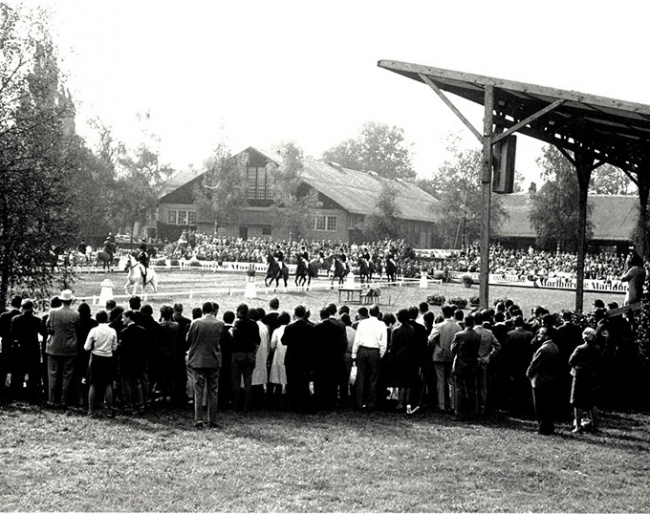
In the lead-up to the 2022 World Championships Dressage in Herning, Eurodressage's history buff Silke Rottermann is taking a look back in history and reviewing the event through time. Experience the magic of dressage from more than sixty years ago.
Finally Official - The First Dressage World Championships 1966
Recalling all four legged dressage World champions since 1966, the grey Westfalian Mariano (by Ramzes AA - Oxyd) was probably the one with the least advantageous conformation of all. Clearly stamped by his Polish bred Anglo Arab sire, Josef Neckermann’s heart horse was the big surprise at the first official World championships in dressage, enchanting with beauty, elegance and faultless precision.
Thanks to the rules, which were different back then, the meagre German doyen Neckermann (1912-1992) remains the only rider in history taking back home two gold medals on two different horses at the same World Championships.
Berne, Host of First World Championships Dressage
The magnificent Swiss Cavalry School (EMPFA), located near the famous Rose Garden of the Swiss capital of Berne, offered the perfect stage for the inauguration of the FEI’s dressage World championships which took place from 25 - 28 August 1966.
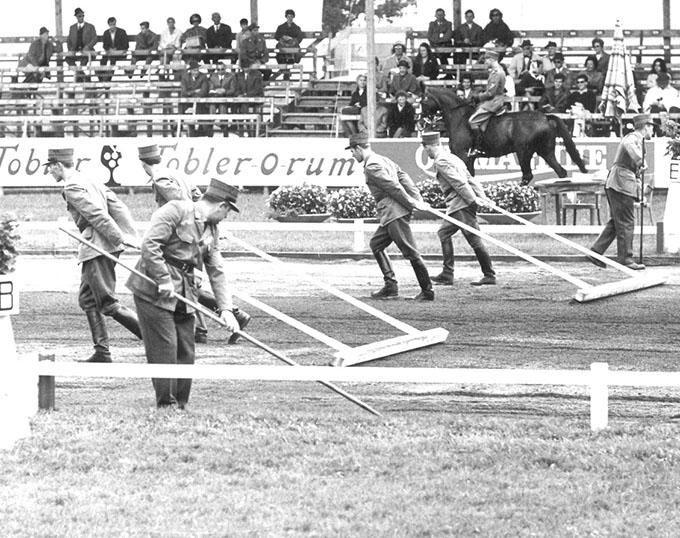
School (EMPFA) took care the surface is all ready for
their mate Henri Chammartin
Photo by Roland von Siebenthal / SVPS Archive
The idyllically located Swiss Cavalry School with its numerous stables, in- and outdoor arenas was the ideal place for it. The Swiss were courageous in creating a huge dressage arena, for the first time consisting of sand (and river gravel), with high and roofed tribunes on each long side as well as outdoor seats on the short sides.
Their efforts were well rewarded because a surprising amount of spectators visited the beautifully decorated dressage arena over the five days of competition. Organized by the commander of the Cavalry School, Colonel Mange, and Werner Stamm, the first official dressage World championships became a real success. It was also enabled by the countless riders, drivers and grooms of the school who acted as volunteers and lent all their helping hands.
Top of Europe - Top of the World
Dressage undoubtedly remained an exclusive European affair for a very long time. To launch official World championships was certainly a rather bold step in the right direction, although it still was a long way to go, until riders from all continents took part.
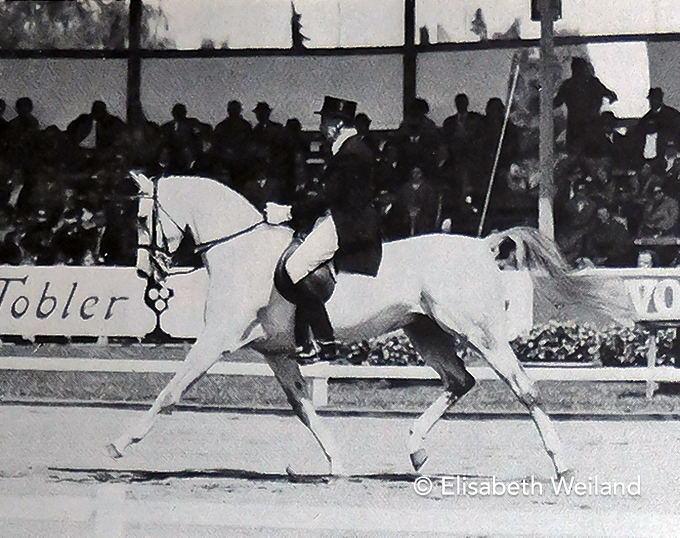
Mariano (by the Anglo Arab Ramzes), Dr. Josef Neckermann
managed to win the Grand Prix and the ride-off
Photo: Elisabeth Weiland / Archive Thomas Frei
There were 24 riders from 6 nations contesting the team medals and the qualification for the ride-off of the best 6 the day after. Germany, the Soviet Union, Switzerland and Sweden were the four countries sending full teams of three, the Czechoslovakian Republic had two individual riders and the USA had the already mentioned one in Berne. Great Britain had nominated a ladies’ team, but was forced to withdraw it due to the Swamp Fever restrictions.
Because the field in the Grand Prix was quite small, riders could start a second horse. Dr. Josef Neckermann and Dr. Reiner Klimke made use of this, while the medal favorites Germany, Switzerland and the Soviet Union also sent individual riders. The Swiss had six starters at whole of who no less than four were members of the host facility and riders of the Cavalry School of their country. It was a tradition which slowly faded in the years to come. Not unexpected, the German team had the biggest contingent in Berne with 5 riders and 7 horses in the Grand Prix.
The Grand Prix / Team Competition
Unlike nowadays, in 1966 the horses which started in the Grand Prix had the opportunity to warm themselves up in an Intermediate class where they also met non-starters of the Grand Prix.
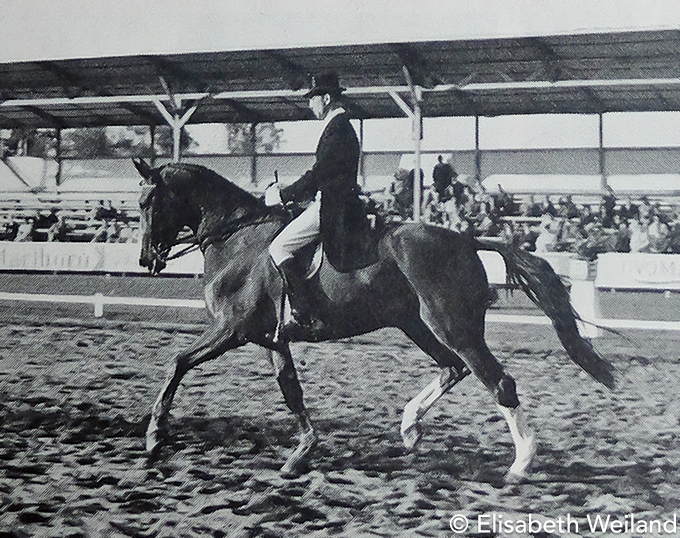
ahead of all other horses, but
had to settle for individual bronze
with the Hanoverian chestnut Dux.
Photo by Elisabeth Weiland / Archive Thomas Frei
The victorious Tokyo team of Dr. Reiner Klimke and his 15-year-old Hanoverian gelding Dux (by Duellant), Harry Boldt and his 11-year-old Westfalian gelding Remus (by Ramzes AA) as well as Dr. Josef Neckermann and his identically aged Holsteiner mare Antoinette (by Anblick xx) was never challenged by the Swiss team which lacked the outstanding ride to do so. Placing 2nd (Klimke), 3rd (Boldt) and 4th (Neckermann), the team won the first team competition at World championships with remarkable 118 points leeway.
Six of the first ten places in the Grand Prix were taken by German riders, with the best Swiss in 5th place. Double European and Olympic champion of 1964, Henri Chammartin, was best of his team, but still 9 points behind the worst German team rider. His highly refined Swedish bred gelding Wolfdietrich (by Daladier xx), whom he had debuted at Olympic level in 1960 and who at 15 came into the autumn of his career, was less brilliant than in the past and couldn’t remain faultless. The silver medalists of Rome, Gustav Fischer and his 13-year-old tall Swedish gelding Wald (by Drabant), came 8th, with Tokyo team mate Marianne Gossweiler 9th on her Holsteiner-Lipizzan crossbred Stephan.
The jury, consisting of Colonel Nyblaeus from Sweden, General du Breuil from France and Colonel Hasselmann from The Netherlands, put the riders from the Soviet Union in third place, although significantly behind the two leading nations. Their famous Akal-Teke Absent, Olympic champion 1960, was missing in Berne, but their team had three young horses good enough taking the bronze. The future Olympic champion Ivan Kizimov with the 8-year-old Ukraine bred gelding Ikhor (by Khobot) who had already won bronze in Tokyo two years earlier at just 6 years of age; the young couple of Nikolaj Mikhailov and the thoroughbred Khingan xx who was the youngest horse of the field at age 6 and the enchanting light-footed and highly refined ten-year-old Russian Trakehner Pepel (by Pilgrim) with Elena Petushkova.
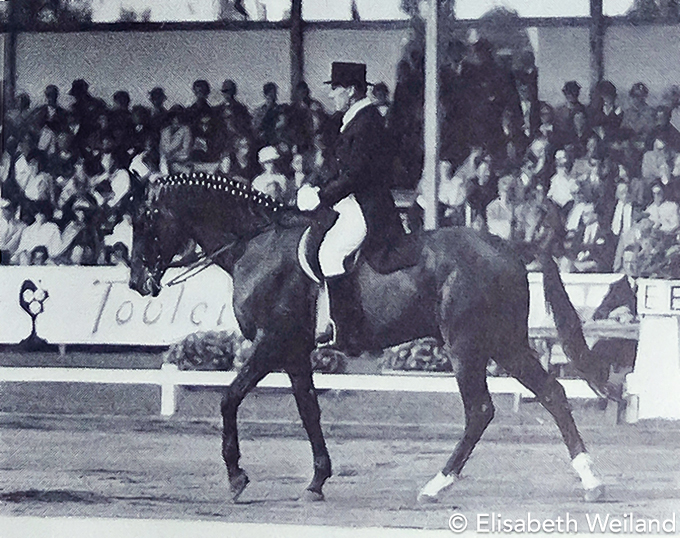
Games) for Ikhor with Iwan Kizimov from the Soviet Union.
1966 only eight years of age, the brown gelding came 6th in
the Grand Prix and even 5th in the ride-off.
Photo: Elisabeth Weiland / Archive Thomas Frei
In the mid 1960s dressage generally still seemed quite influenced by different schools of training. This was proven by the comment of the former Olympian and chief rider of the Cadre Noir, then O-judge, Georges Margot from France. Deeply rooted in his own country’s equestrian tradition, he described the German team’s performance at Berne in the L’Année Hippique as following: "Perhaps it lacked the poetry, instead precise prose had been offered."
Although the team ranking held no surprise, the winner of the Grand Prix certainly did. Just about two years before Berne, Dr. Josef Neckermann had taken over the clearly Arab influenced Westfalian gelding Mariano who like Boldt’s Remus was sired by the Anglo Arab Ramzes AA. The 164 cm small, but long legged grey had won his first Grand Prix at Dortmund just months prior to the Worlds and was considered too unreliable to be included in the German team, so Neckermann rode him as his second horse and won one single point ahead of Klimke and Dux. While Mariano was extremely intelligent and very sensitive, he also loved an audience and the pretty big crowds in Berne apparently did him very well.
The Ride-Off / Individual Competition
The six best pairs of the Grand Prix got the chance to ride for the individual medals in a so-called ride-off.
Four Germans, one Swiss and one Soviet rider contested for becoming the first World champion in dressage in the history of the FEI. Because Josef Neckermann’s two horses had been in the top 4 of the Grand Prix, he was the only rider who had two chances for an individual medal. If this was logical or fair in global terms, is anyone’s guess, but those were the rules back then.
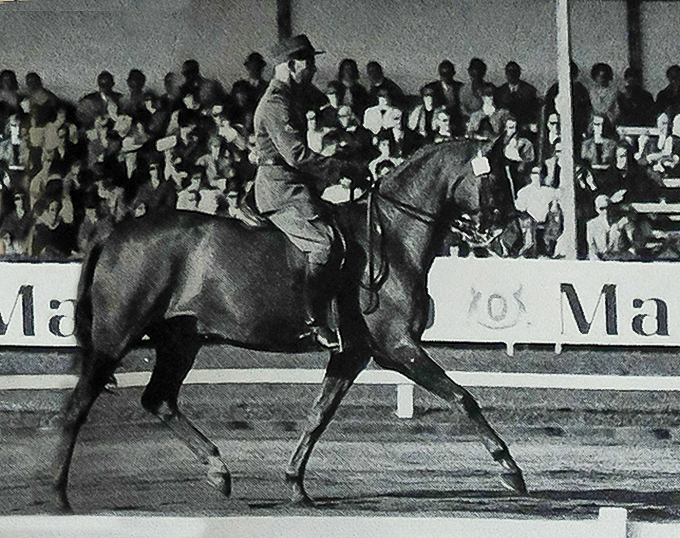
European champion Wolfdietrich showed a few weak
spots which hindered him to crown himself at the door-step
of his stable at the Cavalry School. Team silver and a 4th place
individually for one of the most enchanting horses of the 1960s.
Photo by Elisabeth Weiland / Archive Thomas Frei
Henri Chammartin had probably hoped to gift his country an individual medal with the most beautiful Wolfdietrich, but even though they showed a stronger ride than in the team competition, it was only enough for the ungrateful 4th place for the rider with the exemplary seat and position. With his team mount Antoinette behind Chammartin, Josef Neckermann did not play safe with his second iron the fire and showed a faultless ride with Mariano. Having been neither easy regarding his temperament nor perfect in his conformation, the 11-year-old was the only horse scoring over 1500 points.
On that sunny late summer day in Berne, Josef Neckermann was written into the history books of equestrian sport as the first World champion of his discipline. Little did he know on that day that the 6th placed Soviet Ivan Kizimov would challenge him the crown at the Olympic Games in Mexico-City just two years later.
Breeding at the 1966 World Championships
Just looking at photos of the first placed horses in the Grand Prix in Berne 1966 shows how little uniform dressage horses had been 56 years ago.
On the one side the winner Mariano and the 4th placed Wolfdietrich, highly refined types which showed the direction in which dressage breeding would move decades later. On the other the old fashioned looking heavy boned Hanoverian Dux or the tiny Westfalian Remus lacking size and meaningful lines.
In the field of 24 horses there were still a few pure-bred thoroughbreds, like the Russian chestnut Khingan xx or the Swiss owned Blendish xx. The two Westfalian greys Mariano and Remus were both by the Anglo Arab Ramzes AA who was a legend in post war Germany, standing stud at Count von Nagel-Doornick’s legendary stud Vornholz near Warendorf.
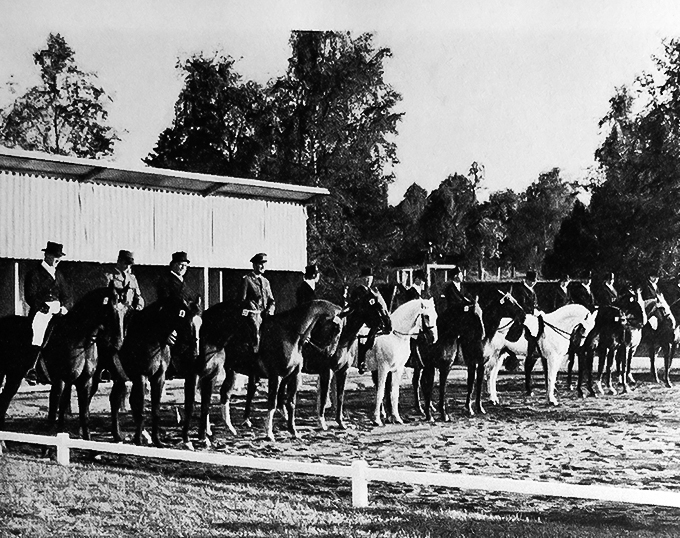
for the prize-giving: 1966
it was nothing out of the ordinary.
Dr. Klimke’s Hanoverian Dux was a typical descendant of his famous sire Duellant, with a big frame, strong bones and the typical chestnut colour with white markings. He represented a type of dressage horse which has now long disappeared and to which also Granit (Hanoverian by Gong-Ast) belonged to. This huge moving horse of Gina and Nadine Capellmann’s father Kurt placed 12th in Berne.
The three Holsteiners Antoinette (by Anblick xx), Arcadius (by Wanderfalk xx) and Waldfee (by Wanderfalk xx) all mirrored the attempt to refine the old fashioned types by the use of thoroughbred sires. The 14-year-old mare Waldfee of German individual Vroni Meyer-Johann who narrowly missed the individual ride-off with a 7th place in the Grand Prix even had a dam by a thoroughbred (Trebonius xx).
The Soviet team’s horses all had a different breeding, but the tendency to use refined horses with a lot of blood or pure thoroughbreds was also well detectable in Berne where the black Russian bred Trakehner stallion Pepel (by Pilgrim) was the most striking one, going back to the legendary Pythagoras.
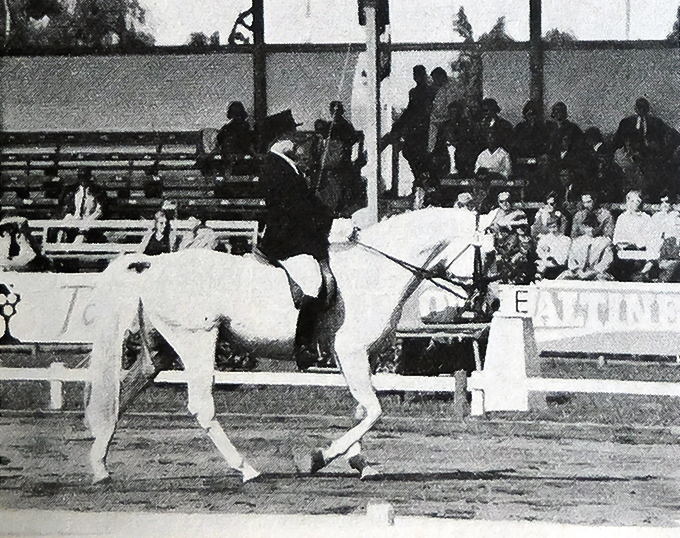
and finished 4th of 4 teams.
And even though Rudolf Traven’s
grey Helios only ended in 20th place, he showed
one of the
best walks of the field.
Photo by Roland von Siebenthal / Archive Thomas Frei
The Swedish team was made up completely from horses from their own breed. The 11-year-old mare Red Eve of Margareta Tengelin was another offspring by Drabant (-Novarro), while Nina Slöör’s (later Swaab’s) beautiful chestnut Casanova (by Utter) shared the dam with Gaspari: Russi (by Haffner). The horse would be on Sweden’s Olympic bronze medal winning team six years later and enjoy a long international career.
The two other Swedish horses were both just 9 years of age in Berne: Higgins, a heavy chestnut by Infant-Novarro and the grey stallion Helios by the Arab Jäger ox. The latter, ridden by Rudolf Traven, reappeared on the US Olympic team two years later with Edith Master.
Text © by Silke Rottermann for Eurodressage
Continue Reading: World Championships Berne 1966 Through The Eyes Of…
Photos ©
Roland von Siebenthal / Archive of the Swiss FN
Elisabeth Weiland and Roland von Siebenthal / Archive of Thomas Frei - Schweizer Kavallerist.
Special thanks to Elisabeth Weiland, Nadine Niklaus of the Swiss FN and Thomas Frei who opened the archives for the illustration of this article
Reference List
„CDIO Bern - Weltmeisterschaft der Dressurreiter“, in: Schweizer Kavallerist, 15th September 1966, page 15-21.
Gottfried Trachsel, Weltmeisterschaft der Dressurreiter - Erfolg der hohen Gänge?“, in: Schweizer Kavallerist, 15th September 1966, page 21.
Josef Neckermann, Im starken Trab, FN-Verlag, Warendorf 1992, page 142-151.
Max E. Ammann, The FEI Championships, Lausanne 2007, page 59/60, 326, 335.
Sankt Georg Almanach 1966, Verlag Sankt Georg, Düsseldorf 1966, page 134/135.

Related Links
Scores: 1966 World Championships
A Klimke Festival in Switzerland
1964 Tokyo Olympics: Marianne Fankhauser, the First Swiss Woman at the Olympics and Straight into the Medals
Greatest Oldies: Wolfdietrich, Chammartin’s Aristocrat
Greatest Oldies: Mariano, the First World Champion in Dressage
Greatest Oldies: Antoinette, Josef Neckermann's Prima Donna